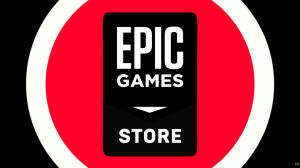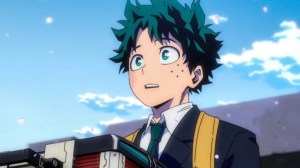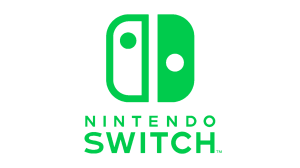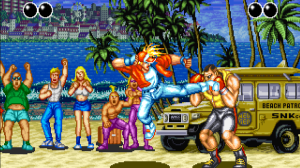
This November Astro City and Mavel’s mastermind Kurt Busiek comes to Image Comics with a new high fantasy series, Tooth & Claw. Joined by artist extraordinaires John Dewey and Jordie Bellaire, Busiek and the T&C team are building a vast and intricate world on par with the level of thought and detail he puts into his long running masterpiece Astro City.
Videos by ComicBook.com
Kurt and I had talked all things Tooth & Claw this past week:
So tell us about Tooth & Claw. What is this story all about? In the press release, I think we called it “Conan meets Kamandi meets Game of Thrones,” which I suppose is better than calling it “Lord of the Rings meets Richard Scarry’s Biggest Busy-Day Book Ever!” It’s a big sprawling epic fantasy set in a world of beast-people, is what it is. There’s this whole civilization built on magic — floating wicker cities, airships, the works — but they’re facing a crisis. Magic is drying up, slowly fading away. So they’re looking at the end of their way of life, and it’s seemingly inescapable. But one wizard has a plan — she’s going to recruit others, and pool their power to cast an insanely-complicated spell — one that’ll actually reach back in time to before the era of magic. There’s a fabled champion back then, the mighty hero who unleashed magic into the world in the first place. So what they’re going to do is, they’re going to reach back, snag him, and pull him into the present to do it again. Problem solved, right? Well, not exactly. Because the spell doesn’t work quite like they planned, and the great champion isn’t quite who they expected, and things go screwy very, very dramatically. But the spell _does_ work, and they _do_ get the champion. And what follows, though it doesn’t follow remotely smoothly, is a big-ass quest of sorts, with a questionably-willing hero, to save the world. Only to save the world, first they’re going to have to understand why the world is the way it is to begin with. And saving it isn’t going to restore it to what it was — it’s going to completely upend it and change things in some very, very big ways. But all that’s going to unfold over time. In the immediate here-and-now, it’s going to be an adventure, a big sprawling adventure full of exotic creatures and magic and action and brutality and radioactive golems and pack-roaches and tricksters and legends and gods and more, as our heroes fight to survive and maybe to learn what the hell’s going on. And it’s gorgeously, gorgeously illustrated by Ben Dewey, who was born to draw this series — he draws the best animal-people ever, and makes the world around them immediate and textured and believable — and Jordie Bellaire, who’s color work builds beautifully on Ben’s art. It’s a stunning-looking book; even the lettering adds to it all, making the whole thing a visual treat. I tell you, if the writer’s only up to the heights the rest of the team is reaching, it’s going to be pretty damn cool. Tell us a little bit about the cast. Will there be a main protagonist in the story going forward, or will this be more of an ensemble cast? Overall, there are two lead characters, and a lot of characters who’ll fade in and out of the stories as we need them. The two lead characters are the Great Champion, about whom I don’t want to say very much, because he’s a mystery at the beginning of the series and I don’t want to give anything away — and Dusty, a young pup of one of the dog-tribes, who’d be a teenager if he was human. But who knows what he is in dog years? Dusty’s life is going to be torn apart by tragedy in the wake of the spell, so when the Champion heads off on his journeys, Dusty winds up traveling with him. He’s kind of our viewpoint character — a relatively ordinary guy (for values of “ordinary” that include being the son of a mercantile sorcerer and an anthropomorphic bull terrier, at least) who knows the world the series starts out in, so he can ground us in it as we go from there to other lands. Beyond that, early in the series, we’ve got Gharta the Seeker, a crusty warthog-wizardess who has little interest in the ivory-tower academics of the other wizards, but who needs their help to save the world; Sandorst the Exacting, a self-important martinet of an owl-wizard, Goodfoot the Trader, a coyote-woman who’s got secrets of her own, Seven-Scars and the bison-tribes, and lots more. Giraffe-wizards, bat-people…and once we get past the first story, it’ll get even weirder. How long have you been developing Tooth & Claw? The first issue has a depth and breadth to it that implies a really strong base of world building and development. I’ve been messing around with the idea for at least a decade, I think. It all started out because I wanted to write KAMANDI and DC wouldn’t let me, and so I eventually figured out I didn’t want to write KAMANDI after all, because that book will always be under the shadow of Jack Kirby, so however you do it, you’re going to wind up doing it “wrong,” because you’re not Jack Kirby. So I started thinking of ways I could do a series that had aspects of what I liked about KAMANDI, but wasn’t KAMANDI. No warring gorillas and lions, no “last boy” — and eventually, something new started taking shape, something that was magic-driven rather than science-driven, that was elaborate and textured and rococo where Kirby was blunt and powerful. Something that was as much inspired by Jack Vance’s DYING EARTH as by Kirby’s KAMANDI. And along the way, it picked up other influences — from CONAN, from Milt Caniff’s classic TERRY AND THE PIRATES, from pulp magazines of the Thirties to mid-century “slick” magazines, to Craftsman architecture and barely-remembered HULK stories and tons more. But from very early on, I knew it had floating wicker cities full of beast-wizards, and I knew they were going to try this one desperate spell… Is this designed to be an on-going series? Do you have an end in mind, or is this more of an exploratory story? We definitely have an end in mind, and we start working toward it right from the inside front cover of #1. But it’s not an ending that we’ll get to quickly. It’s a big world, with a lot to see, and a lot of secrets to reveal. So it’ll take us a good long while to get from beginning to ending. Think of it as a finite series, but finite like SANDMAN or Y THE LAST MAN. We’ll get to the end, sooner or later, but we’ve got a big tapestry to explore along the way. I think one of the trappings of high fantasy fiction, and even sci-fi, is that they often fall into heavy exposition in a way that sometimes sacrifices the actual story. One thing that stood out to me with this book, was how you managed to do some serious world building without using tedius expositional narration. You build and show a massive, intricate world without actually ever telling the reader outright what the world is. Could you talk a little bit about your creative approach to balancing exposition with story in a massive story like this? One of the things I like about high fantasy is the language, the narrative, the texture of the prose. But I didn’t want to load the comic down with lots and lots of captions, I wanted it to work as comics. So in part, we had to make that texture visual — make you see the world in pictures and understand that it’s a world with lots of depth and complexity, lots of specificity to the way it works. That’s where Ben’s abilities come in so importantly — he can draw this world in a way that feels complicated, while keeping the storytelling direct and clear. On top of that, I have to figure out how to let the stories unfold in a way where what could be big chunks of exposition unfold naturally, so the reader gets to see it and understand it, and understand the implications of it, without lots of explanation. If we dramatize the world correctly, then we can show you how interesting it is; we don’t have to tell you. As I was writing the first issue, I had to keep reminding myself to let the reader see and understand the world, to let it breathe on the page. Originally, the three-page scene that opens the book was one page, and we kind of scampered through the plot until we got to a nice dramatic ending — but I had to back off and let the scenes breathe, let the story show us the world rather than hurrying through it with expository captions. So we don’t actually get to where I planned to end #1 until the end of #2. But it’s a stronger series because of it, because the reader gets welcomed into this world rather than hurried through it. I also built in pages 4 and 5, which let me indulge in a little Vancean prose, a way to get some of that richness of language and description you expect from a high fantasy into the issue, without having it get in the way. I won’t say more about that because I want readers to experience it fresh, but I think it makes for a nice, distinctive entry into the story and the world, both in terms of exposition and in terms of atmosphere. We’ve got more ways to keep the world intricate and involving without bogging down in description, so it should be fun to play with them as we go. One thing that really stood out in the first issue is the skill with which you presented the story. It feels fresh and innovative, but also refined and senior in its execution. I’m curious about how you see and approach this project in relation to your other works. Do you have to put yourself in a different headspace to write Tooth & Claw than you’re in to write Astro City? Very much so. ASTRO CITY, for all that it’s a different world from the worlds of, say, Marvel and DC, is a familiar world, a world that plays into reader expectations of the genre. We need the world, the context of the stories, to be familiar, so we can subvert expectations and have the stories themselves be surprising and unusual. So I’m working there with audience expectations in some very specific ways. TOOTH & CLAW, though, is a different world, a different context — and we don’t want it to feel familiar. Plus, TOOTH & CLAW is an ongoing narrative, an adventure that flows from issue to issue, while ASTRO CITY is, at heart, an anthology of discrete stories that need to work as separate units. So the rhythms of it, the viewpoints, it’s all very different. I kind of have to shake off my ASTRO CITY self to get into TOOTH & CLAW, and then shake that off to get back to ASTRO CITY. But that’s one of the reasons it’s fun. I like variety, and I wouldn’t want to be stuck writing only in one voice, one approach. I want to keep doing different things. What’s the creative collaboration like with Ben Dewey and Jordie Bellaire? Do you write in full script? I do write a full script, but that’s only the starting point. It’s a very collaborative process — Ben will do layouts from my script, and then we’ll get together and go over them. I’ll make suggestions, and he’ll throw in ideas he has about how the magic or the culture works, and we’ll refine the layouts from there. Maybe he’ll change panels to beef up an emphasis I want for the storytelling, or I’ll change the script to accommodate a visual idea that works better than what I wrote, that sort of thing. It’s very energizing, to have that kind of back-and-forth, and it permeates everything in the book. Without Ben, Gharta would probably have been something like an opossum or a hedgehog, and male to boot. Thanks to his knowledge of animals and his interest in cultures, we would up building this whole different context of African wizardry that’s just background for now, but it’ll play into the series later. And in the meantime, it helps us make the characters more distinctive, more specific. Everything gets better. With Jordie, we ship the pages off to her and she ships them back all beautifuled-up — but even there, she’ll ask questions that’ll make me figure out more character and cultural differences, and we get to look over her shoulder electronically and ask for specific effects that’ll enhance the story. Jordie also made a couple of suggestions after she read the first-draft lettering that made me go back and rewrite pages here and there, to make things that much better. So the whole team’s open to input from everyone else — JG designed out logo from a sketch by Ben that had a little input from me, and then Ben reworked JG’s logo to make it feel more organic — and it just feels to me like everyone’s fully engaged in the book, doing whatever they can to make the whole thing better, rather than sticking to their one craft area. It’s been a great collaboration so far, and I’m eager to see how it develops. What else are you working on these days? Obviously you’ve still got Astro City going on, but what can you tell us about other projects? Not a whole lot, because ASTRO CITY and TOOTH & CLAW are the only things that are actually on the schedule. I’m doing a few other things, but most of them haven’t been announced yet, so I wouldn’t want to give them away. But there’s some pretty cool stuff coming from me, and I’m getting to work with some awesome artists. A couple of things I can mention: We’re waiting on final contracts for an ARROWSMITH project Carlos Pacheco, Jesus Merino and I are set to do for Vertigo, and I’m almost done writing BATMAN; CREATURE OF THE NIGHT, a thematic sequel to SUPERMAN: SECRET IDENTITY that’s being stunningly drawn by John Paul Leon. I can’t tell you when either of those will actually see print, since they’re not yet scheduled. But hey, that’s something, right? What are you reading/watching/listening to these days that has you excited? What might you recommend? In comics, I’m loving SAGA, FABLES, SANDMAN: OVERTURE, SEX CRIMINALS, THE 6TH GUN and lots more, and I’m loving the fact that there are tons of reprints of classic comic strips, like Leonard Starr’s ON STAGE and Alex Raymond and John Prentice’s RIP KIRBY. In prose books, I’ve recently discovered the work of Greg van Eekhout, and can’t recommend his new novel CALIFORNIA BONES enough — it’s the start of a trilogy, and it’s just wonderful. I’m also reading a lot of crime fiction — Robert Crais, Michael Connelly and John Sandford, to pick a few authors — and fantasy-horror by Joe Hill and Stephen King. On TV, this fall seems to be booming with superhero and comics-based shows, but I’m most hooked by THE GOOD WIFE and HOMELAND, and I’m having fun watching FOREVER and SCORPION. That ought to work as recommendations, yes? |








